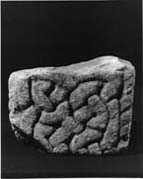Select a site alphabetically from the choices shown in the box below. Alternatively, browse sculptural examples using the Forward/Back buttons.
Chapters for this volume, along with copies of original in-text images, are available here.
Object type: Fragment of cross-shaft [1]
Measurements: H.21.6 cm (8.5 in); W. 27.4 cm (10.75 in) D. 18.5 > 17.8 cm (7.25 > 7 in)
Stone type: Coarse-grained, massive yellow sandstone
Plate numbers in printed volume: Pl. 18.94-97
Corpus volume reference: Vol 1 p. 56
(There may be more views or larger images available for this item. Click on the thumbnail image to view.)
A (broad): Enclosed within an incised cable moulding are one and one half registers of pattern A turned on one side.
B (narrow): Enclosed within an incised cable moulding are two crossed ribbon animals. The head of one is to be seen on the left with an ear extension which passes over the tail and under its body; the ear extension of another beast is also visible.
C (broad): Enclosed in a grooved moulding are parts of two registers of pattern A turned on one side.
D (narrow): Enclosed in an incised cable moulding are one and a half registers of a key pattern.
The key pattern links this piece with Lindisfarne 5-6 and Alnmouth, and the origin of the ribbon animals is also plausibly Lindisfarne 1. However, the close mesh of flat crossing bodies is perhaps more like Aycliffe 2. The piece could be seen as the last vestige of the link with the Lindisfarne tradition or as part of the Hiberno-Saxon revival in the later sculpture of co. Durham (Introduction, p. 32). Adcock (1974, 309-10) claims that the interlace patterns, which are of the same unit measure, have been cut by using a template.



